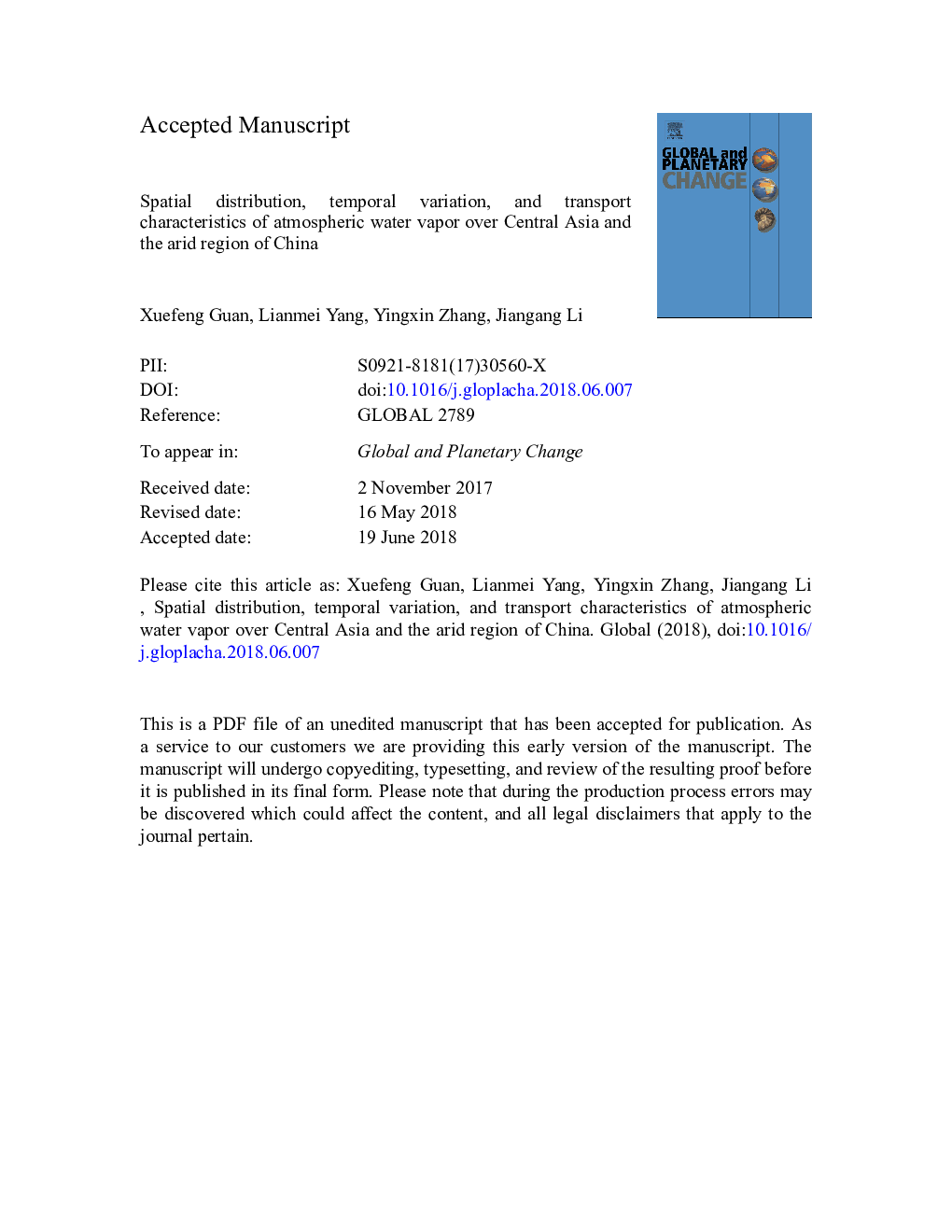| کد مقاله | کد نشریه | سال انتشار | مقاله انگلیسی | نسخه تمام متن |
|---|---|---|---|---|
| 11025028 | 1701038 | 2019 | 77 صفحه PDF | دانلود رایگان |
عنوان انگلیسی مقاله ISI
Spatial distribution, temporal variation, and transport characteristics of atmospheric water vapor over Central Asia and the arid region of China
ترجمه فارسی عنوان
توزیع فضایی، تغییرات زمانی و ویژگی های حمل و نقل بخار آب جوی بر آسیای مرکزی و منطقه خشن چین
دانلود مقاله + سفارش ترجمه
دانلود مقاله ISI انگلیسی
رایگان برای ایرانیان
موضوعات مرتبط
مهندسی و علوم پایه
علوم زمین و سیارات
فرآیندهای سطح زمین
چکیده انگلیسی
This study evaluated the spatial distribution, seasonal/annual variability, and transport characteristics of water vapor over CA-AC during the period 1979-2012, based on ERA-Interim reanalysis data. (1) Located in a low-moisture area of the mid- to low latitudes, CA-AC has a richer water vapor in the south and west, and the plain area than that in the north and east, and the mountainous regions. A decreasing trend of annual average precipitable water-vapor content (PWC) was detected during 1979-2012, which could be attributed to the decrease of PWC in winter. There is no obvious interannual and interdecadal variation of annual CA-AC PWC but the seasonal mean PWC have interannual variability at different time scales.(2) Water vapor in CA-AC is derived primarily from the Mediterranean, Black, and Caspian seas in spring, autumn, and winter, but from the Atlantic Ocean and high latitudes of the European continent in summer. (3) Most of Central Asia is characterized by water vapor divergence in spring and summer and by water vapor convergence in winter. Water vapor converges throughout the year in Kyrgyzstan and Tajikistan in Central Asia and in northern Xinjiang in the arid region of China. Perennial water vapor divergence, however, occurs in southern Xinjiang and in the Badain Jaran and Tengger deserts. (4) Water vapor transport for the five studied countries of Central Asia is mainly via input along the western and southern boundaries and output along the southern and eastern boundaries. In the arid region of China, water vapor transport is mainly via input along the western and northern boundaries and output along the eastern boundary. (5) Water vapor flux was positive in Central Asia but negative in the arid region of China during 1979-2012. The net water vapor flux of CA-AC was found to decrease in spring, increase in winter, and remain largely constant in autumn and summer. (6) Westerly Wind Index can act as an indicative role for water vapor transport in CA-AC. In years with larger Westerly Wind Index, the zonal circulation will be strong enough to bring more water vapor reaching the middle and east part of CA and the AC. More water vapor will be transported to the western part of CA with smaller Westerly Wind Index, while water vapor influx decreases remarkably over the AC because of the intensified longitudinal water vapor transport.
ناشر
Database: Elsevier - ScienceDirect (ساینس دایرکت)
Journal: Global and Planetary Change - Volume 172, January 2019, Pages 159-178
Journal: Global and Planetary Change - Volume 172, January 2019, Pages 159-178
نویسندگان
Xuefeng Guan, Lianmei Yang, Yingxin Zhang, Jiangang Li,
